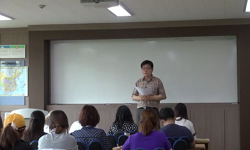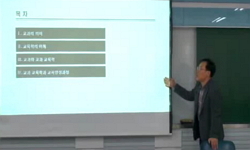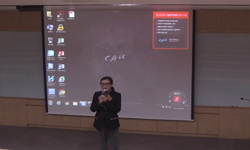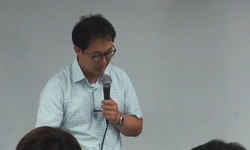본 연구는 미디어 교육이 국어 교과에 수용될 수 있는 이론적 근거를 마련하고 이에 따라 국어과에서 미디어 교육이 행해지고 있는 현황을 분석하고 나아갈 방향의 제시에 목적을 둔다. 그...
http://chineseinput.net/에서 pinyin(병음)방식으로 중국어를 변환할 수 있습니다.
변환된 중국어를 복사하여 사용하시면 됩니다.
- 中文 을 입력하시려면 zhongwen을 입력하시고 space를누르시면됩니다.
- 北京 을 입력하시려면 beijing을 입력하시고 space를 누르시면 됩니다.
https://www.riss.kr/link?id=T10932562
- 저자
-
발행사항
서울 : 한양대학교 교육대학원, 2007
-
학위논문사항
학위논문(석사) -- 한양대학교 교육대학원 , 국어교육전공 , 2007. 2
-
발행연도
2007
-
작성언어
한국어
- 주제어
-
발행국(도시)
서울
-
형태사항
vi, 109 p. ; 26cm.
-
일반주기명
Abstract : p. 97-100
국문초록 : p. i-iii
참고문헌 : p. 94-96 - 소장기관
-
0
상세조회 -
0
다운로드
부가정보
국문 초록 (Abstract)
본 연구는 미디어 교육이 국어 교과에 수용될 수 있는 이론적 근거를 마련하고 이에 따라 국어과에서 미디어 교육이 행해지고 있는 현황을 분석하고 나아갈 방향의 제시에 목적을 둔다. 그리하여 현재 7차 중등학교의 국어 교육과정 속에 얼마만큼 미디어 또는 미디어를 포함한 대중문화에 대한 내용을 미디어 교육적 차원에서 담고 있는지를 분석해 보았다. 그리고 그 결과를 우리보다 그러한 과정을 먼저 겪으면서, 자국어 교육의 방향을 잡아가고 있는 호주의 사례와 비교하여 그것이 우리 국어 교육에 주는 시사점을 파악하고자 하였다.
시대가 변화하고, 미디어가 발달함에 따라 전통적인 리터러시의 개념도 발전하여, 미디어 리터러시로까지 확장되고 있다. 미디어 리터러시란 다양한 형태로 구성된 메시지들을 접근하고, 분석하고, 평가하고, 커뮤니케이션하는 능력이며, 창조하고 실제 상황에 적용하는 능력까지 포함하는 것이다. 그리고 이러한 미디어 리터러시는 바로 이 사회를 이해하는 방식 중 하나로 기능할 수 있을 것이다.
미디어는 끊임없이 현대인에게 다양한 방면의 정보를 제공하고, 매스 미디어는 현대인의 생활과 깊은 연관을 가지고 있다. 결국 미디어 자체가 하나의 언어 현상이며 문화 현상인 것이다. 듣기, 읽기, 말하기, 쓰기를 통한 의사소통 교육 및 문학과 언어를 통한 문화 교육의 일부를 담당해 왔던 국어 교과는 이러한 다양한 미디어를 교과 내에 수용할 필요가 있다. 이는 학습자들의 실제적 삶의 경험을 국어과 교육으로 수용함으로써, 현실에서 요구되는 다양한 소통 능력과 문화 능력을 제대로 기를 수 있게 하기 위해서이다.
이렇게 언어 교육적 측면과 문화 교육적 측면에서 미디어는 국어과에 수용되어 져야 한다는 기준을 바탕으로 현행 7차 국어과 교육과정의 미디어 수용 현황에 대하여 분석하여 보았다. 분석대상은 7차 국어과 교육과정과 교과서로 중등학생에 해당하는 7학년에서 10학년에 해당하는 부분이다.
7차 국어과 교육과정에는 미디어의 변화에 맞추어 교육 내용을 수정하고 보완하려 한 노력의 흔적이 보인다. 그래서 다양한 매체와 관련된 내용이 들어가 있다. 그러나 그 영역이 말하기와 듣기, 쓰기, 읽기 영역에 편중되어 있다. 그리하여 국어지식, 문학 영역에서는 미디어 교육 관련 내용을 전혀 확인할 수 없었으며, 모두 국어사용 기능 영역에 국한되고 있다. 그리고 7차 교육과정에 나타난 미디어 교육은 추상적이고 단편적이며 너무 일반적인 미디어 이용 방법만을 제시하고 있다. 또한 미디어 교육 내용도 미디어를 활용한 교육으로 편향되어 나타나고 있다.
교과서 분석에서도 유사한 한계를 발견할 수 있었다. 국어 교과서 내에 미디어 교육이 체계적이고 일관성 있는 틀을 가지고 수용된 것이 아니라 국어 교과에서 제시하고 있는 학습 목표의 실현을 위한 보조 수단으로 특히, 언어 사용 능력의 신장을 위한 도구로, 읽기 영역에 치중되어 수용되었으며 관련 경험의 확장 차원에서 수용되었다는 것을 알 수 있었다.
반면에 호주의 자국어 교육과정과 교과서 분석을 통해서 다음과 같은 점을 발견할 수 있었다. 첫째, 국어 교육 안에 미디어 교육이 수단으로서가 아닌 하나의 내용 조직으로 통합적으로 수용되어 있다는 점이다. 둘째, 다양한 미디어의 활용을 ‘보기’영역과 연관 지어 제시하고, 그러한 활동을 제시하면서 ‘보기’만을 독립하여 제시하지 않고 쓰기나 읽기 능력 계발과 통합하여 제시하고 있다는 점이다. 셋째, 문학 교육에 대한 문화 교육적 접근을 들 수 있다. 넷째, 언어 체계 요소에 대한 새로운 시각을 들 수 있다.
호주의 교과서에서도 여러 가지 시사점을 파악할 수 있었다. 첫째, 미디어와 관련된 다양한 학습 내용이 제시되고 있는데, 이는 쓰기, 읽기, 말하기 등과 연관되어 짜여 있어서 미디어를 통한 통합적인 언어 교육이 이루어질 수 있음을 알 수 있다.둘째, 학생들에게 언어 교육의 필요성을 인식시키기 위한 학생 위주의 언어 교육을 목적으로 제시하고 있고, 학습 내용 또한 교사의 설명부분 보다는 학습자의 활동 위주로 구성되어 있다. 셋째, 학생들의 다양한 사고를 도출하기 위한 시도들이 각 질문에 나타나 있다. 넷째, 비문학텍스트와 미디어 텍스트가 문학 텍스트 못지않게 비중 있게 다루어지고 있다.
이상에서 알 수 있듯이 현재 7차 교육과정의 국어과의 미디어 수용은 그 필요성은 자각하고 있으나 아직 많은 한계를 지니고 있다. 그리고 우리보다 선진적이라 평가받는 호주의 교육과정은 우리가 미처 수용하지 못했던 미디어 교육의 상당 부분을 자국어 교육내로 끌어들이며, 그것이 자국어 교육을 통해 이루어져야 하는 영역임을 인정하고 적극적으로 실제제적인 미디어 교육 활동에 힘을 기울이고 있다. 우리 국어과 교육과정도 국어와 미디어 환경의 중요성을 인식하고, 효과적인 국어 생활을 영위하도록 하며, 정보화 사회에 적응력을 제고하기 위해 이와 같은 내용을 수용하는 방향으로 나아갔으면 한다.
다국어 초록 (Multilingual Abstract)
This study aims to provide a theoretical foundation of incorporating media education into Korean language curriculum and accordingly analyzes current status of media education in language curriculum in Korea. I analyze the 7th Language Curriculum for...
This study aims to provide a theoretical foundation of incorporating media education into Korean language curriculum and accordingly analyzes current status of media education in language curriculum in Korea.
I analyze the 7th Language Curriculum for Secondary School, focusing on how much media-related, or popular culture related content is included in an educational manner. Also, comparing it to the case of Australia which already went through a similar process and overcame obstacles along the way to establish a direction of native language education, I attempt to elucidate its implication to Korean language education.
As time changes and media evolve, traditional notion of literacy also develops, expanding itself to the concept of media literacy. Media literacy is ability to access, analyze, evaluate and communicate messages in differing forms, which also implies ability to create new messages and apply them to the real life. In this sense, media literacy can function as one of the ways to understand the society.
Media have always provided various kinds of information and mass media have been closely connected to people’s lives in modern times. After all, media itself is a linguistic and cultural phenomenon. Language curriculum, which has taken charge of communicational education through listening, reading, speaking and writing as well as cultural education through literature and language, needs to incorporate in it various kinds of media. By embracing learners’ actual life experiences into its curriculum, it would properly cultivate communicational and cultural capacities required by the real life.
Based on the principle that media should be incorporated in Korean language curriculum in the sense of language education and cultural education, I analyze the present status of media in the 7th Korean Language Curriculum. More specifically, my object of study is the curriculum and textbooks for 7th grade to 10th grade, an equivalent of the middle school.
There are some efforts within the 7th Korean Language Curriculum to revise and complement its content of education in order to follow the changes of media: there are contents regarding various media. However, they are limited to speaking, listening, writing and reading areas. As a result, media-related content isn’t found in areas of grammar or literature at all while crowing the area of language ability Furthermore, most of media-related content offers only abstract, fragmentary and general descriptions of media usage. Also, media education is viewed only as the education using media.
Similar limitations are found in the textbooks. Media education isn’t incorporated within the curriculum in a systematic or consistent manner: it is understood only as a secondary means to support educational goals of the curriculum. Especially, it is clear from the analysis that media education serves only as a tool to facilitate language ability in the speaking area, as a way to expand related experiences.
On the other hand, followings are found in the analysis of the Australian native language curriculum. First, media education is integrated in language curriculum not as a means but as one of the substance in a very systematic manner. Second, various uses of media presented in close connection to viewing area are incorporated to the writing or speaking ability as well. Third, they reveal cultural educational approach to literature education. Fourth, they offer a new perspective of elements in language system.
Analysis of Australian textbooks also provides valuable implication. First, there exist a lot of media-related learning materials in connection to writing, reading and speaking, which enables a comprehensive language education. Second, they present as their goal a learner-centered language education which informs them of the necessity of language education and emphasizes activities on learners’ side more than explanations on lecturers’ side. Third, they reveal in each question attempts to facilitate diverse thinking from students. Fourth, non-literature and media texts are treated as importantly as literature texts.
In conclusion, the 7th Korean Language Curriculum does recognize necessity to incorporate media education but shows a lot of limitations. On the other hand, Australian curriculum, which is seen to be more advanced than its Korean counterpart, integrates media education as a meaningful part of its language education and actively participates in actual activities of media education. We need to recognize importance of language and media environments and try to follow the example in order to effectively cultivate language ability and adaptability to information society
목차 (Table of Contents)
- Ⅰ 서론 = 1
- 1. 연구의 목적 = 1
- 2. 연구사 검토 = 2
- 3. 연구 범위와 방법 = 5
- Ⅱ 미디어 교육과 미디어 리터러시 = 6
- Ⅰ 서론 = 1
- 1. 연구의 목적 = 1
- 2. 연구사 검토 = 2
- 3. 연구 범위와 방법 = 5
- Ⅱ 미디어 교육과 미디어 리터러시 = 6
- 1. 미디어 리터러시의 개념 = 6
- 2. 미디어 및 미디어 교육의 의미 = 9
- 가. 미디어의 개념 = 9
- 나. 미디어 교육의 의미 = 10
- 3. 미디어 교육의 필요성 = 16
- Ⅲ 국어 교육과 미디어 교육 = 19
- 1. 국어 교육으로서 미디어 교육 = 19
- 2. 국어 교육으로서 미디어 교육의 이론적 근거 = 24
- 가. 언어 교육적 측면 = 26
- 나. 문화 교육적 측면 = 27
- Ⅳ 7차 국어 교과에 수용된 미디어 교육의 현황 및 한계 = 28
- 1. 7차 중학교 국어 교과에 나타난 미디어교육 분석 = 28
- 가. 7차 중등학교 국어과 교육과정 분석 = 29
- 나. 7차 중등학교 국어 교과서 분석 = 34
- 2. 7차 국어 교과에 나타난 미디어 교육의 분석 결과 = 48
- Ⅴ 호주의 자국어 교과의 미디어 교육 수용 현황 = 52
- 1. 호주의 교육제도 = 52
- 2. 호주의 자국어 교육과정 분석 = 53
- 3. 호주의 자국어 교과서 분석 = 63
- 가.『Composing & Responding In English Stage 4』의 경우 = 64
- 나.『English 10』의 경우 = 82
- 4. 호주의 사례가 주는 시사점 = 87
- Ⅵ 결론 및 제언 = 89
- 참고문헌 = 94
- ABSTRACT = 97












